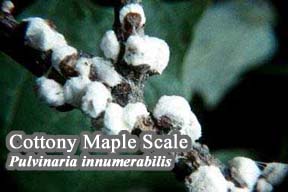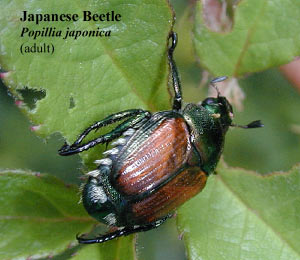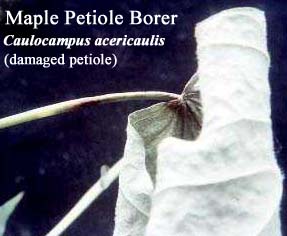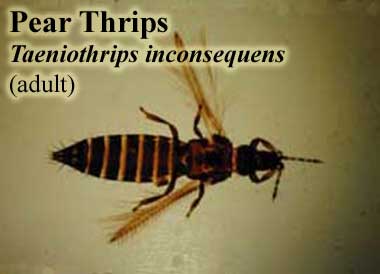Maple (Acer)
Plant Health Problems
Diseases caused by Fungi:
Anthracnose, Discula (Gloeosporium).
This disease is widespread on maples, particularly Norway and sugar maples. Large irregular areas on sugar maple leaves turn reddish-brown, usually involving one or more lobes of the leaves. On Norway maples a purplish discoloration runs along the veins. On both, the fungus fruits abundantly in little pale pink masses. Petioles may also be attacked. From a distance, infected trees look scorched.
Rake and dispose of fallen leaves to reduce the chance of infection in the following season, and maintain vigor of the trees with adequate water during dry periods and fertilization in the spring. Since this disease is usually not a serious problem for the health of the trees, chemical controls are usually not necessary.
Frog-eye leaf spot, Phyllosticta minima.
Small (1/4 inch) grayish-tan spots with purple borders are scattered over the leaves. Tiny black dots in the spots are fruiting bodies of the fungus. Usually more severe on red, sugar, and silver maple but can occur on Japanese and Norway maple.
Rake and dispose of fallen leaves to reduce the chance of infection in the following season, and maintain vigor of the trees with adequate water during dry periods and fertilization in the spring. Since this disease is usually not a serious problem for the health of the trees, chemical controls are usually not necessary.
Tar spot, Rhytisma acerinum and Rhytisma punctatum.
This fungus produces raised black spots that look like blobs of tar on the leaves. Depending upon the fungal species, spots can be irregular and up to one-half inch in diameter or can appear as tiny, pinpoint dots in clusters. Silver and Norway maples are very susceptible, but it is usually unsightly rather than serious, although significant defoliation can occur.
Raking and disposing of fallen leaves is sufficient for control, but it is important to maintain the vigor of the trees with adequate water during dry periods and fertilization in the spring. For more information, see the fact sheet on Common Problems of Maple.
Wilt, Verticillium albo-atrum.
This disease is more common on Norway and Japanese maples than on sugar maple. Foliage on one branch or one side of the tree wilts, and sapwood occasionally shows intermittent green or green-black streaks. Some trees die quickly but others linger. The infection usually starts in the roots since this fungus is soilborne.
Once a tree is infected, there are no effective controls for this disease. However, it is helpful to maintain vigor of the trees with adequate water during dry periods and fertilization in the spring. Avoid planting susceptible species as replacements, such as elm, catalpa, ash, or linden. Resistant plants such as apple, crabapple, beech, oak, walnut, or pines can be used as replacements.
Bleeding canker, Phytophthora cactorum.
Sap oozes from spots which can appear anywhere on the trunk. When dry, the sap darkens resembling dried blood, which gives this canker its name. Cankers are very long, up to several feet in length, with indefinite margins, on the trunks of both ornamental and sugar maples. Leaves above the canker wilt, and branches may die. In chronic cases leaves are small, and dieback appears slowly. The tree may die in from 2 to 4 years. Sapwood beneath cankers contains reddish-brown radial streaks with olive-green margins.
No control is known, but maintaining the vigor of the trees with adequate water during dry periods and fertilization in the spring may help.
Nectria canker, Nectria cinnabarina.
Cankers start as depressed areas on the bark which quickly girdle twigs, branches, or trunks. Leaves, beyond the point of attack, wilt but remain attached to the tree. Eventually everything beyond the canker dies. Either the Nectria or wilt fungus or a girdling root may be suspected in cases where one branch of a tree turns red in the fall before the rest of the tree.
Pruning well back of cankered area and disposing of infected wood removes a source of new infection.
Shoestring root rot, Armillaria mellea.
This fungus penetrates the bark of collar and roots at and below the ground level, eventually killing the tree. The crown may have small leaves and produce little or no new growth. This is followed by dieback of branches. The growth increment of the trunk is slight. The fungus may be recognized by the rhizomorphs which look like black shoestrings but are actually cables of fungus threads protected by a rubbery black cover. They are produced in the ground or along or under the bark of the roots or collar. White mycelial fans on the inside of loose bark are also indicative of infection by this fungus. The mushrooms, or fruiting bodies, are honey colored with a pebbly top, about 2 to 6 inches in diameter, and appear in clumps near the base of the tree in wet fall weather. Attack by this fungus is apt to occur on older trees or trees stressed by drought, particularly where environmental conditions have changed, such as cutting surrounding trees, near construction, or areas with a change in drainage.
There are no effective controls, but maintaining the vigor of the trees with adequate water during dry periods and fertilization in the spring may help to keep the trees alive. The fungus persists in roots for at least 30 years. Only resistant trees, such as catalpa, gingko, sweet gum, or scots pine, should be used for replacements.
Diseases caused by Physiological/Environmental Factors:
Environmental problems.
Norway maples have been widely planted, and though they are short-lived, they are fairly hardy in our climate and are more tolerant of road salt than sugar maples. Maple leaves are subject to sunburning, especially if hot sunny days follow a prolonged period of cloudy weather in spring. Sunburning resembles anthracnose infection and can be differentiated only by laboratory examination. Sunburning usually occurs on the south or southwest side of a tree, especially on those in exposed locations. Early infection of maple wilt in a large tree, or a girdling root, may resemble this trouble.
Girdling roots.
Norway maples are notorious for producing roots that grow around the tree instead of away from the trunk in the normal manner. As girth increases, the girdling root strangles the tree, causing leaves on one side to scorch, or small leaves sparsely arranged on twigs, and a dying back of branches. Growth is slow, and the whole tree dies. A flat side on the trunk usually indicates a girdling root is below ground.
When the root can be found early enough and cut off at the point where it begins to curve, the tree can recover.
Insect Problems:
Cottony Camellia or Taxus Scale, Pulvinaria floccifera.
This soft scale attacks Euonymus, holly, Hydrangea, maple, Taxus and many other plants. The scale overwinters as a second instar mostly on twigs. Brown, oval females produce long white cottony egg masses on the undersides of host leaves in late spring. Crawler treatments should be applied after the eggs have hatched around mid-June, between 800 and 1400 degree days. Crawlers will disperse to new areas, insert their mouthparts, and begin to feed. Once settled, the young scales never move again. There is one generation per year. Black sooty mold grows on the honeydew that scales excrete as they feed. Horticultural oil can be applied during the dormant season. A summer rate of horticultural oil, along with deltamethrin, carbaryl or malathion, which are among the compounds registered for use against this insect in Connecticut, can be applied to foliage in late June against crawlers. Restricted-use imidacloprid can be applied by a licensed pesticide applicator in spring for season-long control, but should not be applied to plants, such as holly or certain cultivars of hydrangea, that are highly attractive to pollinators. An alternative systemic product containing acetamiprid may be considered for managing cottony scales on bee-attractive plants.
 Cottony maple scale, Pulvinaria innumerabilis.
Cottony maple scale, Pulvinaria innumerabilis.
This is a brown, oval, soft scale on the bark of the branches of silver and red maple in winter, but in June the large egg masses are formed, and their wax covering resembles a tuft of cotton. The young crawl in July and some of them live for a time on the leaves, but return to the twigs to pass the winter. Among the compounds registered for use against this pest in Connecticut are horticultural oil, imidacloprid and malathion. The best means of control are a dormant horticultural oil spray applied in early spring or imidacloprid applied as a systemic to be taken up by the roots. However, sugar maple trees may be more sensitive than other maples to injury from horticultural oil, and trees being tapped for syrup production should not be treated with imidacloprid. Malathion sprays in early July will control the young crawlers. Consult the labels for dosage rates and safety precautions.
Cottony maple leaf scale, Pulvinaria acericola.
This scale closely resembles the cottony maple scale to which it is closely related, but differs from it in that the egg masses are formed on the leaves instead of on the bark. This insect is not very abundant, but occurs on sugar maples. The eggs hatch in late May or June and the scales live on the leaves until October when they migrate to the trunk where they overwinter on the bark. If control is necessary, among the compounds registered for use in Connecticut are horticultural oil, imidacloprid and malathion. A dormant horticultural oil spray or imidacloprid applied as a systemic to be taken up by the roots can be effective, but imidacloprid should not be used on trees being tapped for making syrup. However, sugar maple trees may be more sensitive than other maples to injury from horticultural oil. When the eggs are hatching late in May, a malathion spray should give good control. Consult the labels for dosage rates and safety precautions.
Gall mites and midges.
On maple leaves, there are several forms of galls caused by mites and midges. Some of the more common of them are the maple leaf spot gall, Cecidomyia ocellaris, on red maple; the maple bladder gall, Vasates quadripedes, and the maple spindle gall, Vastates aceriscrumena, on silver maple; and the gouty vein gall, Dasyneura communis, on sugar maple. Spraying with malathion, which is among the compounds registered for control of this pest in Connecticut, in early May can be helpful in destroying the mites before galls are formed. Consult the label for dosage rates and safety precautions.
Greenstriped mapleworm, Dryocampa rubicunda.
The caterpillars of this insect feed on maple foliage, occasionally defoliating trees. When mature, it is about 1 1/2" long, pale yellowish-green, striped lengthwise with narrow light green and darker green stripes. There are two black spines on the second segment behind the head. The moth emerges in June, has about a 2" wingspread, and is pale pink. A broad pale-yellow band crosses each forewing diagonally. Sprays of carbaryl, malathion, spinosad or Bacillus thuringiensis var. kurstaki, which are among the compounds registered for use against this pest in
 Japanese beetle, Popillia japonica.
Japanese beetle, Popillia japonica.
This beetle, in the adult stage, feeds upon a great variety of trees and plants, including maple. The beetle is 1/2" long, bright, shining green, with copper colored wing covers. Two white spots on the tip of the abdomen show beyond the ends of the wing covers, and there are five white spots formed by patches of white hairs on each side of the abdomen. The beetles begin emerging in late June but their greatest abundance is usually about the middle of July. During drought periods populations of Japanese beetle are drastically reduced.
Japanese beetle traps containing floral and sex attractant lures are readily available at home and garden centers. These traps may help reduce the overall number of beetles. However, beetles often land and feed on plants close to traps, so traps should be placed well away from valued plantings. Feeding on maple foliage can be prevented by using sprays of acephate, azadirachtin, carbaryl or malathion, which are among the products registered for use against this pest in Connecticut. Imidacloprid, applied early in the season as a soil drench, will provide season-long systemic control. Consult the labels for dosage rates and safety precautions. Larvae develop in turf, so treatment of lawn areas should reduce the numbers of beetles. See Lawns, oriental beetle.
Maple callus borer, Synanthedon acerni.
The larva of this clearwing moth is a borer in maple trees, especially around wounds. There is one generation each year. The moth has a wing spread of about an inch; both fore and rear wings are transparent with narrow purplish margins, tips of forewings are pale yellow, and there is a conspicuous black mark 2/3 of the way toward the tip of the front wing. Prevention of injury will be helpful in keeping the larvae out of the trees. Keeping trees vigorous and irrigated during prolonged drought helps to reduce borer injury. Permethrin, which is among the compounds registered for use against this pest in Connecticut, applied as a trunk spray can control the moths before they lay eggs. A more thorough control would be expected if treatments are timed to coincide with adult activity. Consult the label for dosage rates and safety precautions. Adult flight can be monitored with pheromone traps.
Maple mealybug, Phenacoccus acericola.
This mealybug infests sugar maple, and there are two or three generations each year. In summer, masses of white wax, 1/4" or more in diameter, resembling tufts of cotton or wool, may be seen on the undersides of the leaves. These contain the living or dead female and about 500 eggs. When mature, males crawl into bark crevices and transform in white cottony wax cocoons. The adults emerge 2 weeks later. At the approach of winter, the immature females crawl into the crevices of the rough bark of trunk and branches, and there secrete wax to form protecting cases in which they pass the winter. They often emerge on warm days and crawl about the bark. The white woolly cases are always noticeable in the crevices of the bark at the base of the larger branches and on the upper portion of the trunk on infested trees.
 Maple petiole borer, Caulocampus acericaulis.
Maple petiole borer, Caulocampus acericaulis.
In certain years under sugar maple trees near the last of May, one may see on the ground many fallen green leaves with their stems severed a half inch or less from the blade. The blades drop first and a few days later the stems fall. The insect responsible for this injury is a small sawfly that lays an egg in the leaf stem. The larva tunnels in the stem and just before maturing cuts it off. The larva drops and enters the ground to pupate and remains there until the following spring. Imidacloprid, which is among the compounds registered for control of this pest in Connecticut, applied as a systemic to be taken up by the roots may be effective against this pest. Consult the label for dosage rates and safety precautions.
Norway maple seedpod borer, Nepticult sericopeza.
This insect injures and cuts off the leaves of Norway maple in a manner quite similar to that of the sawfly borer in the leaf stems or petioles of sugar maple. The adult is a tiny moth. It commonly infests the seedpods and sometimes the leaf petioles, causing many leaves to drop. This pest is usually not abundant enough to require control. Spraying with malathion, which is among the compounds registered for use against this pest in Connecticut, late in May should control it. Consult the label for dosage rates and safety precautions.
 Pear Thrips, Taeniothrips inconsequens.
Pear Thrips, Taeniothrips inconsequens.
These small piercing-rasping insects damage early spring growth on mainly maples but also black cherry, birch, beech, ash and other fruit trees. The slender, brownish, 1/10" long adults have narrow fringed wings that are as long as the body. White, wingless larvae have red eyes. Larvae overwinter in the soil, going through a resting stage before emerging as adults in early spring. Eggs are laid in leaf veins and petioles causing scarring. Larvae feed in swelling buds causing foliage to emerge yellow, tattered and distorted. Severely injured leaves may drop prematurely causing a thinning of the canopy. This reduces root reserves and lowers sap production for maple syrup producers for several years.
Management of this occasional pest involves keeping trees in good vigor by watering when rainfall is insufficient and fertilizing yearly. Chemical control is difficult because insects feed inside buds. Syrup producers should not use insecticides.
Saddled prominent, Heterocampa guttivitta.
The caterpillars of this insect occasionally become so abundant as to defoliate large areas of woodlands, especially beech, birch, and maple. Occasional outbreaks of this insect have been responsible for periodic widespread defoliation of shade and forest trees in the mountain regions of New England and New York, especially of beech, birch, and maple trees. The eggs are laid on the leaves early in July and hatch in 9 days. The caterpillars become fully grown in about 5 weeks, when they pupate and overwinter in the ground. There is only one generation each year. The mature larva is about 1 1/2" long with great variation in color and markings. Some are light yellowish-green and some are nearly purple. Many have a purple mark or saddle near the center of the body, but some have no saddle marks and there are all intergradations. The moth has a wing spread of 1 1/2 - 2" and is olive gray without prominent markings. Carbaryl, malathion, or Bacillus thuringiensis var. kurstaki, which are among the compounds registered for control of this pest in Connecticut, can be sprayed on infested foliage. Consult the labels for dosage rates and safety precautions.
Sugar maple borer, Glycobius speciosus.
This is the most destructive pest of the sugar maple. It is a beautiful, black, longhorned beetle with brilliant yellow decorations, including a W-shaped mark across the base of the wing covers. It is about an inch long and emerges in July. The female lays eggs in slits in the bark, and the young larvae tunnel in the inner bark and sapwood, overwinter in a chamber excavated in the sapwood, and the following spring cut large galleries in various directions, though usually in a spiral course upward and partly around the trunk. Sometimes two or more borers in a tree may completely girdle the trunk and the tree breaks. They pass the second winter in chambers 4" from the bark. Two years are required to complete the life cycle. Tree growth over the wound generally results in a series of scars and ridges that show prominently on the trunk.
Choice shade trees may be examined carefully at least twice a year, in September and May, for sawdust on the bark. When a burrow has been discovered, the grubs may be cut out, or killed by running a wire into the burrow. The opening to the burrow may then be closed. Maintaining adequate watering may be helpful in preventing infestation.
Terrapin scale, Mesolecanium nigrofasciatum.
This small, reddish, oval, convex scale occurs on the small twigs of hard and soft maple, often killing them. It varies from 1/16 - 1/8" long and is usually reddish-brown mottled with black. Eggs are deposited in June under the old shells and there is one generation each year. Among the compounds registered for control of this pest in Connecticut are horticultural oil, chlorpyrifos, malathion and imidacloprid. Horticultural oil may be applied in early spring to silver and red maples, but on hard maples it is safer to use a spray of chlorpyrifos or malathion in April. Imidacloprid may also be applied as a systemic to be taken up by the roots. Consult the labels for dosage rates and safety precautions.

